When my son was in grade school, he begged to plant a vegetable garden. I thought it was a great idea; it would get him outdoors and get his hands in the dirt. I diligently tilled a patch of our lawn. We planted tomatoes, lettuce, string beans and green peppers. There was only one problem: my kid was a carnivore and quickly lost interest in our homegrown vegetarian fare.
The next summer, the weeds were chest high, so we turned the garden back to grass. In the process, I discovered stringy vine-like roots, which I yanked out with the rest of the tangled mess.
“I hope you were wearing a long-sleeved shirt,” said my husband when I mentioned the roots. “That might be poison ivy.”
“In our lawn?” I replied doubtfully. “I’m not allergic to it anyway.”
A week later, itchy, oozing blisters erupted all over my arms, torso and neck. The plant’s roots, which had laid dormant under our lawn, beaten back by the mower, had given me my first case of “urushiol-induced contact dermatitis”.
Until the rash disappeared, I was the family pariah. No one wanted to get near me for fear of contracting my malady. They needn’t have worried. I would only have been contagious if I had failed to shower after my anti-gardening exploits. (The blisters contain only water.)
How you get the rash without touching the plant is only one misconception about this toxic plant. There are more:
-
Myth #1: Poison ivy and its cousins, poison oak and poison sumac, are the only poison plants in the United States that cause an itchy rash.
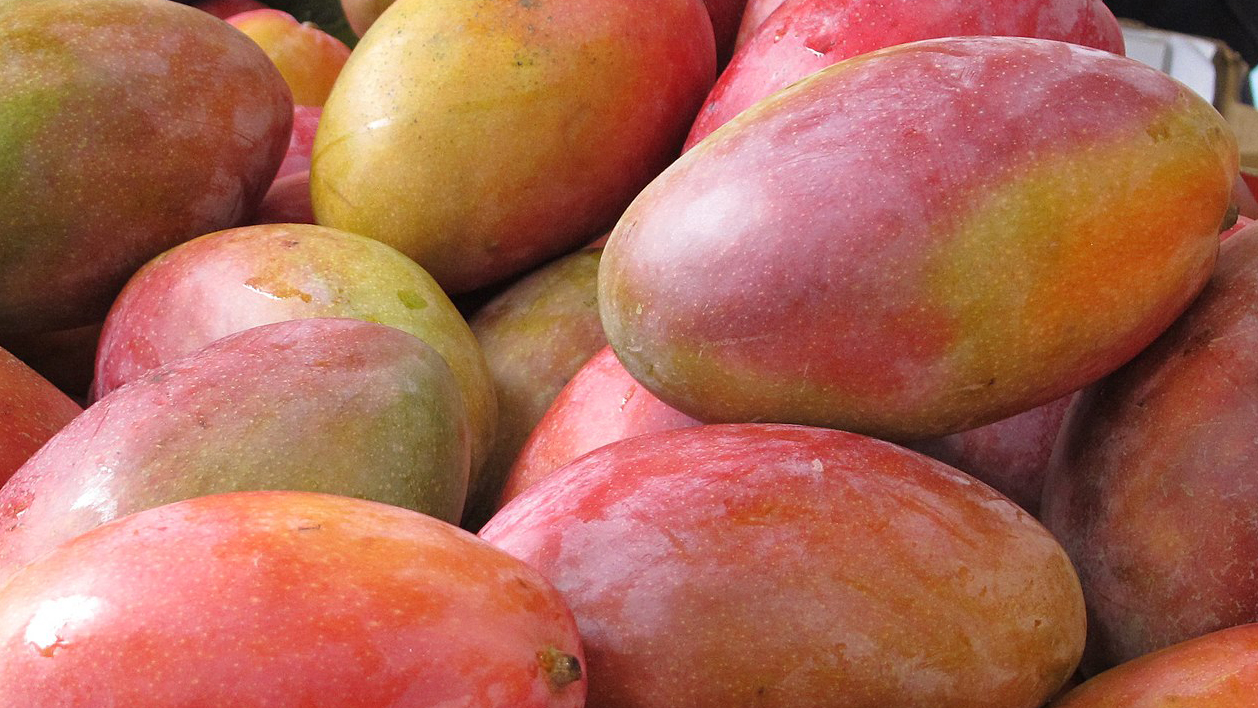
Mangoes in a farmer’s market. By Snapdragon66 [CC BY-SA 4.0] from Wikimedia Commons Poison ivy grows in every state except for Alaska and Hawaii, but you can still get a similar rash in Hawaii if you rub mango skins against your body. You can also get blisters on your lips if you eat the sweet fruit directly off the rind.
Poison ivy and mangoes belong to the Anacardiaceae family. Other plants in this family, such as cashews, also produce a rash-inducing oil. All cashew nuts are shelled and cooked before they arrive at the grocery store, which neutralizes their rash-inducing toxin. Unfortunately, the urushiol oil in poison ivy is resistant to heat.
Interestingly, pistachios, another member of the Anacardiaceae family, doesn’t cause a rash.
-
Myth #2: Animals naturally avoid poison ivy because they sense it’s toxic to touch.
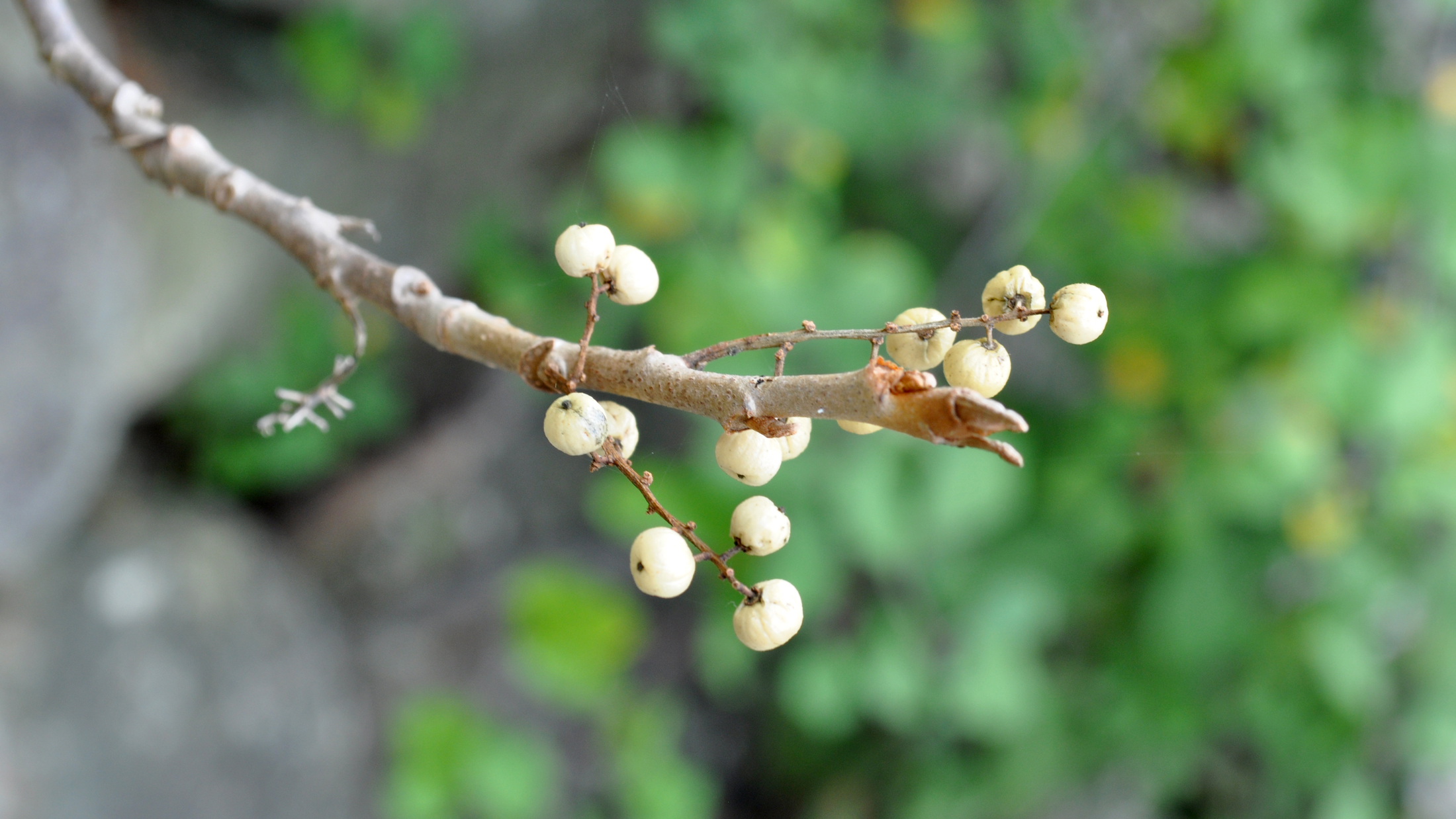
Poison ivy berries. Photo © Lisa Ballard Both mule deer and whitetail deer, who are primarily browsers, seek leafy plants, including poison ivy. According to the South Carolina Department of Natural Resources, birds, including catbirds, chickadees and wild turkeys, sup poison ivy’s smooth, white berries, particularly during the winter when food is scarcer. Black bears, wood rats, raccoons and muskrats also eat the plant’s stems and leaves, and toads hide under it.
Animals may not react to poison ivy, but they can give it to humans. This toxic weed flourishes in open woodlands, especially alongside openings, like footpaths, where it can get sunshine yet not get crushed by hiking boots. If you go hiking with your dog and he romps through a patch of poison ivy, then you pet your dog, your hands pick up the urushiol oil. Until you wash them, any bare skin on your body that you touch can get the rash, and any article of clothing or gear can transfer the itchy toxin to another part of your body or to someone else.
-
Myth #3: If you don’t see three leaves, it’s not poison ivy.
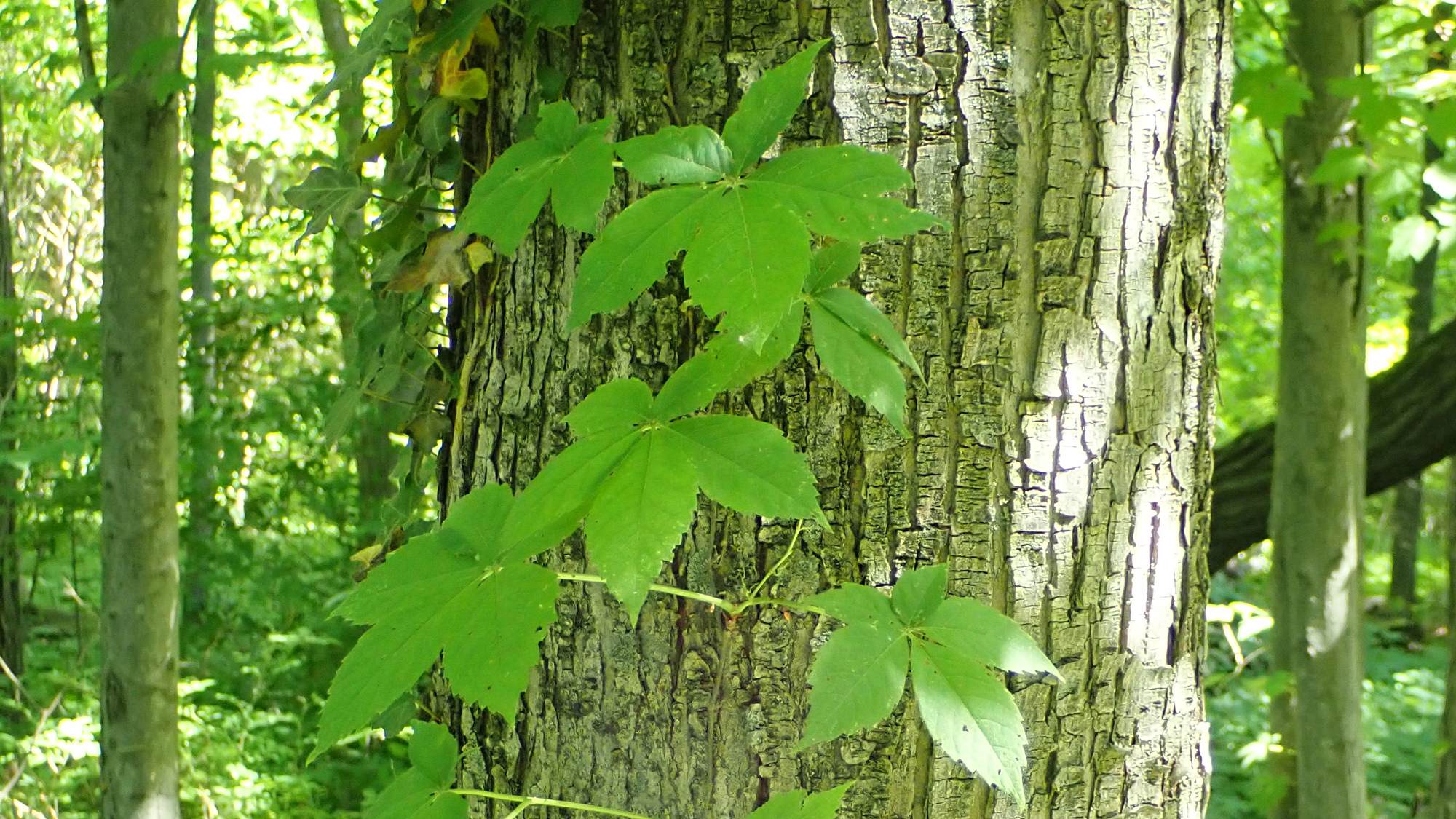
Virginia creeper vine. Photo © Lisa Ballard While the mantra, “leaves of three, let it be”, helps identify poison ivy, which has three toothed, heart- or almond-shaped leaves growing from one point on a stalk, every part of the plant can cause a reaction, including the stems, berries and roots as I inadvertently discovered.
When poison ivy first comes up in the spring, it looks dark red and glossy. The leaves quickly turn the same green as other leaves in a deciduous forest, but if you look closely, there may be tinges of red where the leaves come together. Then, in the fall, they put on a showy display of reds and yellows on par with any maple tree.
This tenacious plant can grow as a stand-alone perennial, shrub, ground cover or vine. As a vine, it sprouts thousands of brown hairs that grasp the bark of its host tree. As it climbs toward the canopy and matures, its stem gets woodier and increases in diameter, up to several inches thick, as if a second tree has grown up hugging the original one.
People often confuse Virginia creeper with poison ivy, but Virginia creeper has five leaves, not three. You don’t want to bathe in Virginia creeper either. Its sap can also cause an annoying rash.
-
Myth #4: I’m not allergic to poison ivy.
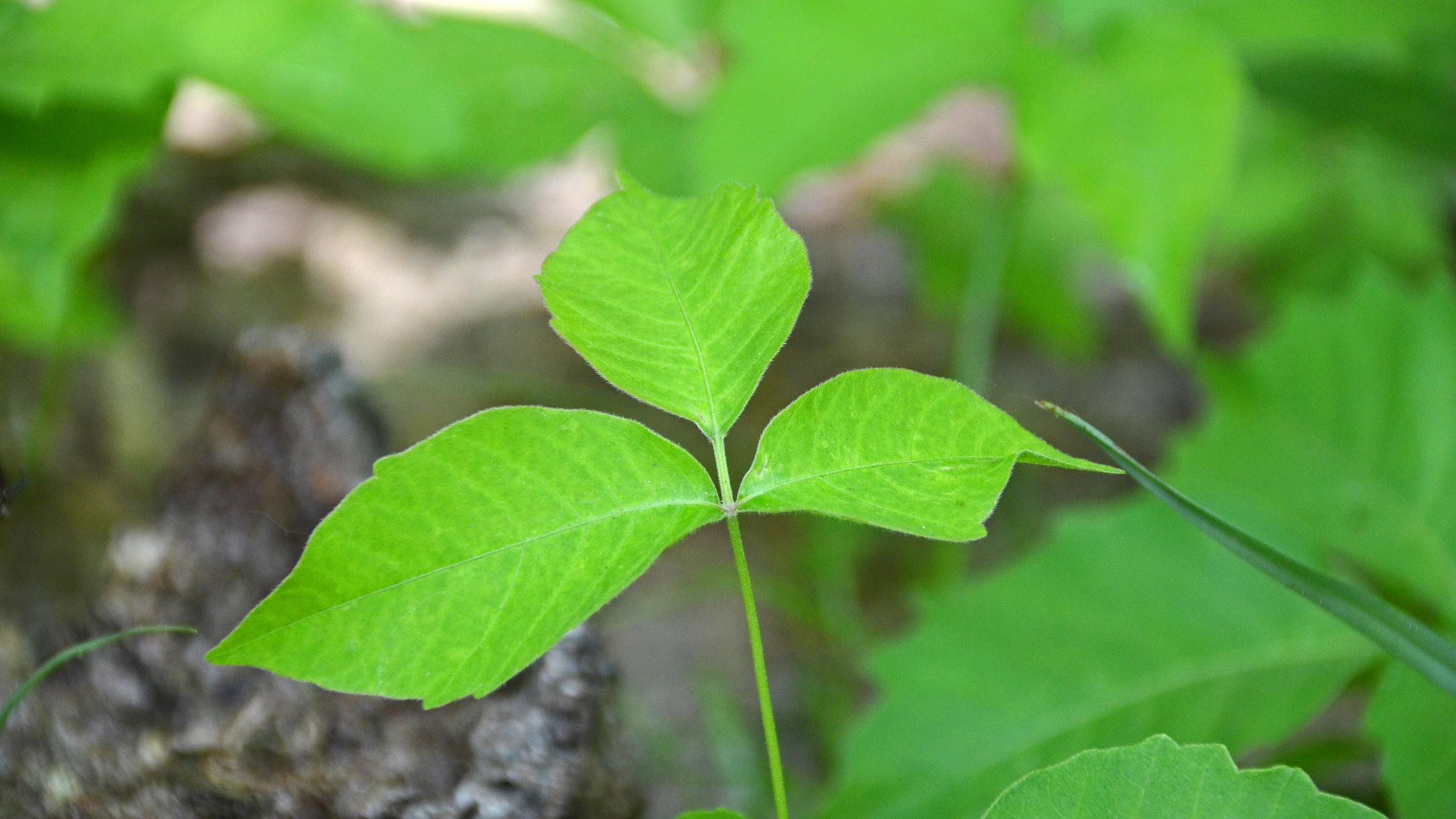
Poison ivy. Photo © Lisa Ballard Don’t kid yourself. According to the American Academy of Dermatology, about 50 million people get the rash each year, making it one of the most-common allergies in the United States.
If you don’t get it the first time you touch it, you will probably get it the second time. Unfortunately, the body doesn’t build immunity. On the contrary, the more times you are exposed to it, the worse the break out. The rash may appear in only a couple of hours on veteran poison ivy sufferers. Among first-timers, it can take up to 10 days.
Urushiol oil binds to the skin in 20 minutes or less, and it’s concentrated stuff. Only one nanogram can trigger the rash. (The average human exposure is around 100 nanograms.) But there’s hope! If you know you’ve touched poison ivy and you immediately wash the exposed area with soap and water, your odds of getting the rash greatly decrease.
If you think a large area of your body may have touched it, take a shower, not a bath. The oil can rise to the top of your bathwater and get on more of your body. If you’re in the backcountry, rinse the area in moving water. Don’t forget to wash your clothes and gear, too.
-
Myth #5: When poison ivy dies, it can’t cause the rash.
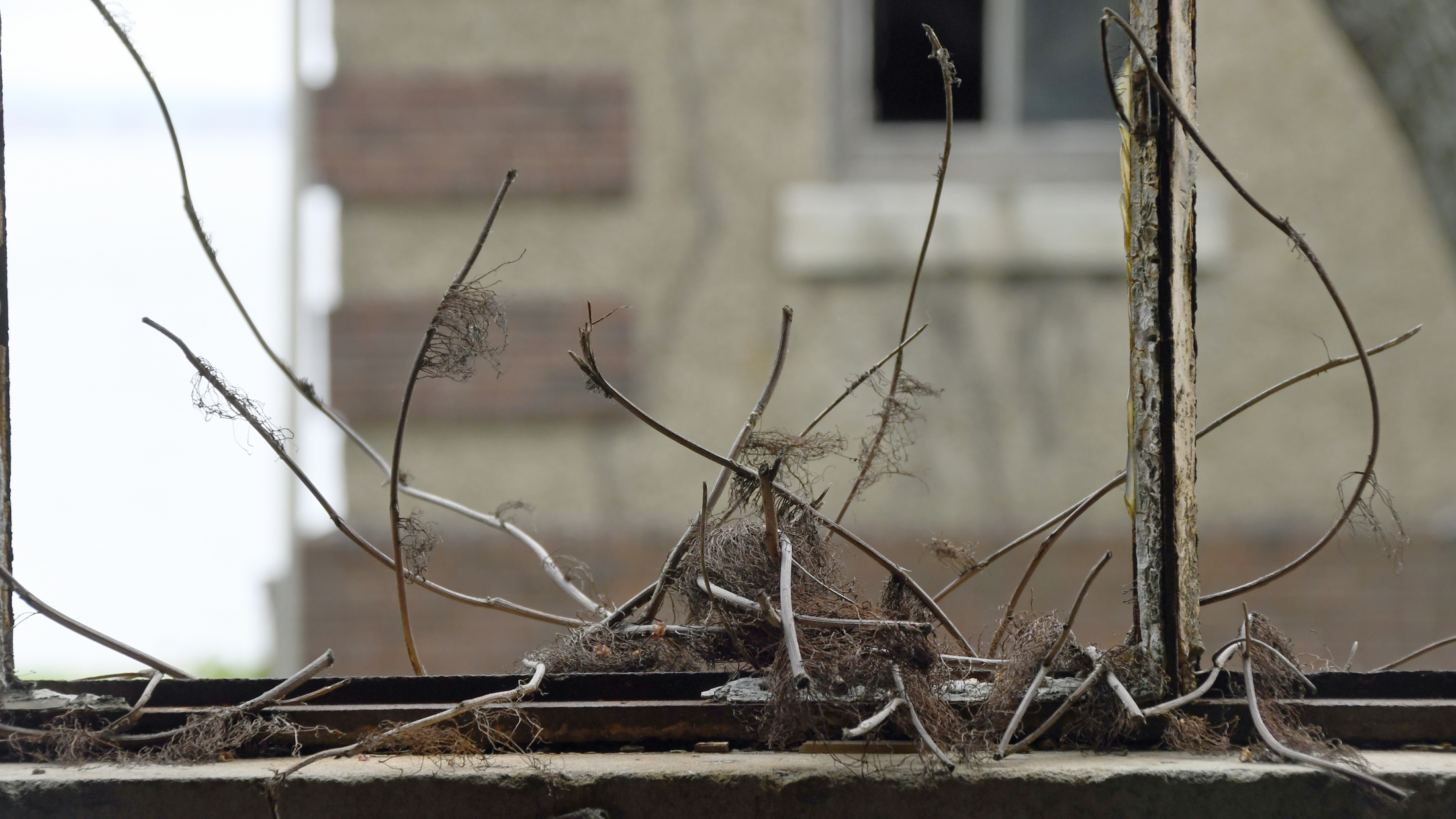
Poison ivy vine on window. Photo © Lisa Ballard Urushiol oil is durable stuff. While the plant won’t produce more of it after it dies, the oil can linger for five or more years. You’ll need a quick trip to the emergency room if you unwittingly burn it in a pile of dead wood, inhaling the smoke, which can carry urushiol oil into your lungs. This nasty toxin can also become airborne from wildfires and lawnmowers.
-
Myth #6: Climate change has no impact on poison ivy.
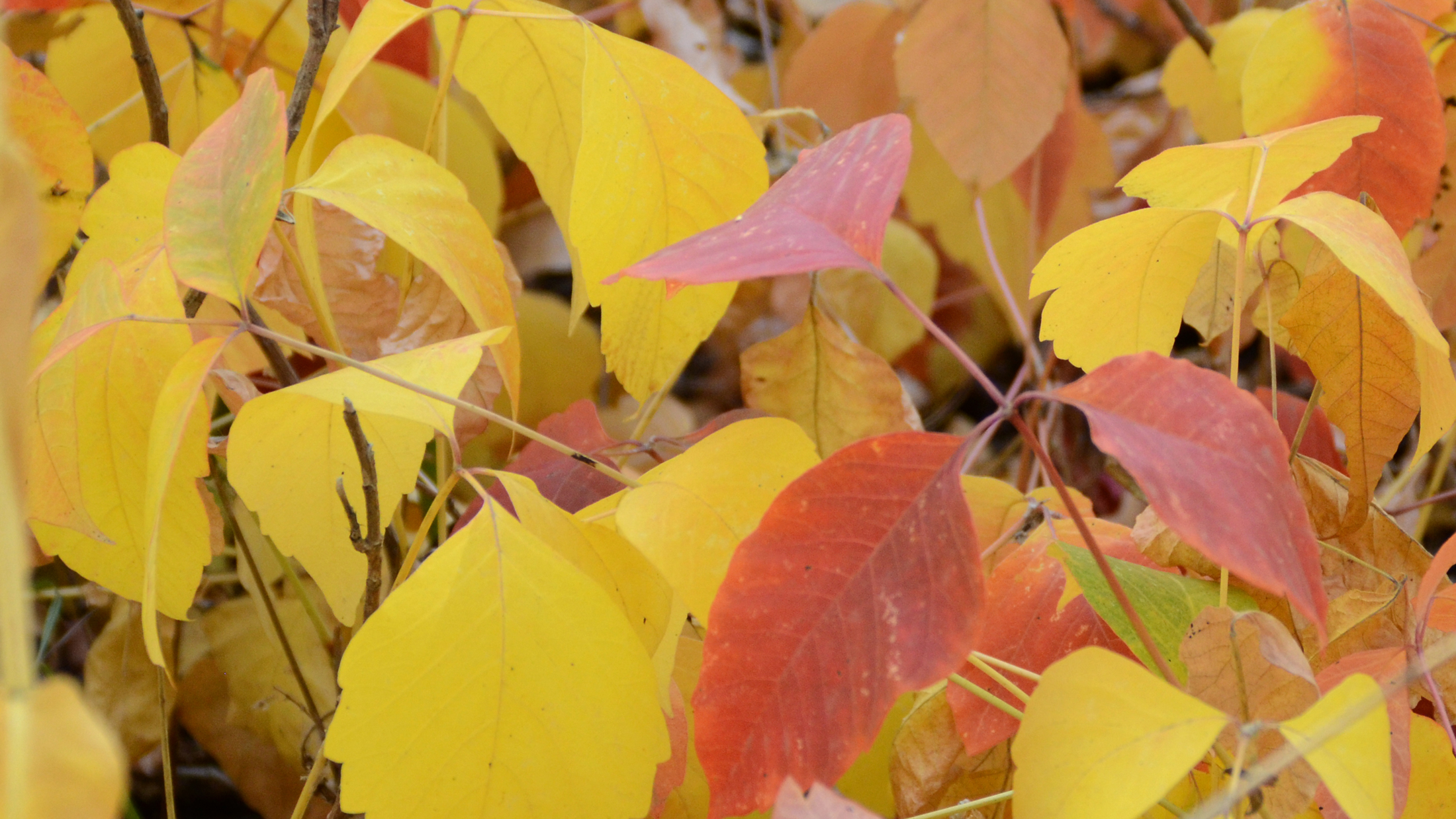
Poison ivy. Photo © Lisa Ballard Historically, backcountry travelers believed they were safe from poison ivy at elevations above 2,500 feet in the East and 4,000 feet in the West, and in desert climates. However, I live at 5,500 feet in the Beartooth Mountains near Yellowstone National Park and see it when I hike. I’ve also seen it in the arid Grand Canyon after a rare, heavy rain storm caused dormant poison ivy to emerge on sandbars.
Poison ivy is creeping higher and drier, but perhaps more unsettling is the fact that it’s getting more potent. According to a 2006 study published by the U.S. Department of Agriculture in Proceedings of the National Academy of Sciences, poison ivy leaves are increasing in size and are coated with more and stronger urushiol oil as levels of carbon dioxide increase globally.
I don’t mean to be an alarmist, just more observant. Whether doing yard work, jogging down a country lane or trekking in the mountains, you can bet I’ll be checking the flora before blithely blundering through it.
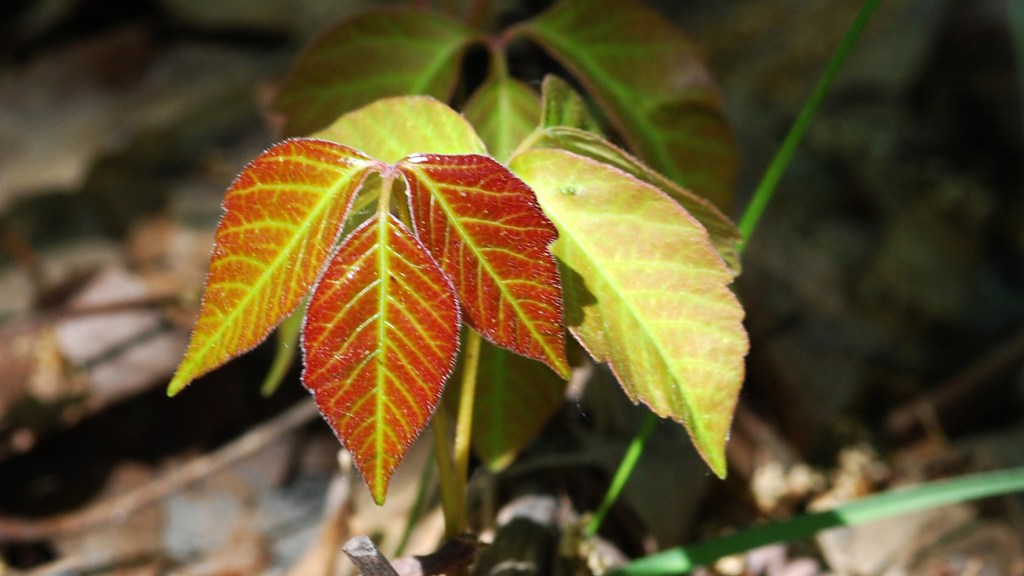



What aboutm Poison Oak?
It’s similar and equally nasty. The rash from poison oak is also caused by urushiol oil.
Ms. Ballard, your informative article sure brought memories of my early encounters with poison oak here in California. I’ve heard it said that poison ivy & poison sumac are east of the Mississippi and poison oak is west of the Mississippi. Any truth to that?
My first experience was in 8th grade when I was biking and hiking off road in Southern California, and your warning about the oil being on one’s clothes or one’s pet is right on. I don’t have a memory of wandering into the underbrush, but I’ll bet my jeans brushed some as I rode my bike on narrow paths in the foothills and got transferred to my hands when I took my jeans off. I got a case so bad I had it everywhere. As a young boy I probably picked my nose, scratched my privates as well as other areas of my body. I had it everywhere and had to figuratively take a bath in Calamine lotion, which had me going to school with pink skin. They say Fels-Naptha bar soap, like the pioneers hand washed their clothes with cuts the oil. Do you think if Dawn dish soap can cut the oil contamination on sea birds, it might work as well on poison oak oil?
The second time I got it, I was skinny dipping with friends on the Illinois River in Southern Oregon, and unknowingly sat in it on a large rock in the middle of the river. It was a fun ride home. When it was my turn to drive, my friends would pass me cold beers to place in my crotch. I remember using bleach to counteract the itch. The sting was more tolerable than the itch. Your advise to be observant is right on.
I really like this range map, which shows both Eastern poison ivy and Western poison ivy (two subspecies of the plant), as well as poison oak:
https://www.bing.com/images/search?view=detailV2&ccid=pCPV5BRK&id=8C07BDD2CBA272DE35A1B664341E34A87BB31096&thid=OIP.pCPV5BRKm6cYpl1-Ve1-IAHaD_&mediaurl=http%3a%2f%2fstatic.ijreview.com%2fwp-content%2fuploads%2f2015%2f07%2fpoison-ivy-2.jpg&exph=335&expw=621&q=poison+ivy+range+map&simid=608037435935690115&selectedIndex=4&ajaxhist=0
Poison oak is generally identified with the western United States.
Needed much more info on identifying the plant and distinguishing it from similar harmless plants, as well as effective strategies to remove it.
A good tip to know for hikers and others, gleaned from an agricultural consultant magazine, is that jewel weed, which often grows in proximity to poison ivy in many regions, can act as a neutralizer. Soap and water or just water is better, but if you’re out away from both and see jewel weed, you can break the stalk and smear the juice on the poison-ivy exposed area of skin.
If you aren’t familiar with jewel weed (or touch-me-nots), google a picture. It has orange flowers in late summer/fall.
Poison ivy and jewelweed often grow near each other. It’s not scientifically proven that rubbing jewelweed on your skin after exposure to poison ivy will neutralize the urushiol oil, but many people believe that. This website is commercial, but it explains this herbal “cure” and shows photos of jewelweed:
https://altnature.com/jewelweed.htm
Other than steroids, lots of steroids, the only thing that helps me is jewelweed based remedies. I have tried all the regular ones I can find.
Also I am sorry but the rash will spread on me without scratching and even after washing myself very very well in the shower. It doesn’t matter. It spreads on me no matter what and it is not reexposure either. I blew my new doctor’s mind a few months ago with how bad it spread and kept spreading. He insisted that it was reexposure but I know how and when I was exposed and it isn’t possible.
You can have a systemic reaction to poison ivy. Typically, you break out where the skin is rubbed or irritated. People who have extreme reactions or who have extensive exposure often react this way.
I manage to get into some several times each summer working in the yard. But I never see anything about how long the urushiol can last on clothing, pets, etc. before it is no longer irritating. Do you know
Urushiol oil is stubborn stuff. It lasts for 5 +/- years on a dead poison ivy plant. Ditto anything else it’s on. You need to wash your clothes, your skin, your pet, your lawn chair, your gardening gloves and anything else that touches it with soap and hot water to get rid of it.
I heard that some researchers found leaves in the pages of old books which monks had collected. After 2000 years the researchers broke out from the oil left on the leaves.
If you pull it and burn it, stay away from the smoke. My husband found out the hard way.
I’m so allergic to poison ivy… it’s a horror to find that it is becoming more potent.. honestly
Thanks for a good article. I learned several things, and am also a little shocked to learn that mangoes have a dark side! I spend time on the Mississippi River and live in Nebraska. I have leaned to look for ivy every time I take a step, and have avoided it for more than a year, until this month. One “myth” I have read many times relates to your statement that the blisters contain only water. I have found that I can get rid of the first spot of ivy (Zantek followed by Dawn soap) but the maddening thing is the burning spots and smears that spread from this now-dried-up spot. Not just water.
Thank you so much for sharing this article.
I’ve also heard that you can get the rash from poison from the wind blowing and/or if burned, the oils from the plant carry through the smoke. So look-out if you’re walking past it or downwind from a leaf pile file that might have the plant in it. Is it true that the oil can travel through the air either by piggy-backing on a breeze or in smoke? Thanks in advance!
It’s true. Beware of brush fires in areas where poison ivy is present. Scroll down through this link to get some info on the airborne risk of urushiol oil:
https://www.webmd.com/skin-problems-and-treatments/guide/understanding-poison-ivy-oak-sumac-basics#1
Great article…….I have hiked through out the state of California and never encountered poison ivy….lots of poison oak….from see level to about 5000 ft…..Oak woodland areas, foot hills of all the mountain ranges, Coast Range and the Southern California ranges. Can you tell me in what counties or area of California we have poison Ivy. Poison oak too, grows as a small bushes and shrub to very large shrubs, to vines crawling as high as forty feet+ into oak trees and grey pines. Very prevalent in our Chaparral areas and riparian ravines. It is used as food (especially the berries) by a great many birds, as well as a nesting location for some.
The area around Oroville, CA for starters, as the company, Manta, offers poison ivy removal services. Sacramento County includes info on poison ivy on its “Network of Care”, and this landscape company offers poison ivy removal services in a number of cities:
https://landscapeflowergrowers.com/s/ca/poison-ivy-removal
While poison oak is by far the more common poison plant, in 2/3 of the counties in California, it’s worth keeping an eye out for poison ivy, too, especially in the southern most tip of California. Check out this range map:
https://www.bing.com/images/search?view=detailV2&ccid=pCPV5BRK&id=8C07BDD2CBA272DE35A1B664341E34A87BB31096&thid=OIP.pCPV5BRKm6cYpl1-Ve1-IAHaD_&mediaurl=http%3a%2f%2fstatic.ijreview.com%2fwp-content%2fuploads%2f2015%2f07%2fpoison-ivy-2.jpg&exph=335&expw=621&q=range+map%2c+poison+ivy&simid=608037435935690115&selectedIndex=0&ajaxhist=0
I don’t know where that range map got its info, but Calflora–a database combining range info from the UC Berkeley and Jepson Herbaria (the *official* keepers of CA plant records) and confirmed observation by professionals–has *zero* reported observations in the state.
I love the taste of mango, but the first one I ate, off the rind of course, blistered my lips and made me itch inside my body. So if I interpret this correctly, I can peel one, rinse the fruit, wash my hands and safely eat it. Please tell me yes!
Hi Mike,
This source says that most mango allergies are to the skin of the fruit, not the pulp:
https://www.verywellhealth.com/mango-allergy-82833
If the body does not build immunity why is there a vaccine?
The vaccine, which is fairly new, desensitizes the body to the chemical in urushiol oil that causes the reaction in humans to poison ivy. There was a good article summarizing the science behind the vaccine in the Toronto Star (April 3, 2012), which was just going into clinical trials at that time. Here’s the link:
https://www.thestar.com/news/world/2012/04/03/poison_ivy_vaccine_shows_promise.html
Every year, I take poison ivy pills with a tiny amt of the oil in them. I’m convinced these help me either not to get it, or to have it less dramatically.
That’s called confirmation bias. You’re taking a placebo. I hope you aren’t paying some quack for that.
My farrier had a terrible time with it because so many clients’ horses wander through it in pastures and as she would handle their legs she would get it on her, even with long sleeves.
No one WHAT!?